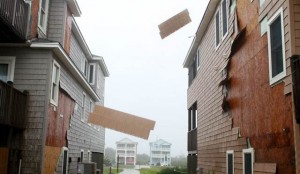Property owners are keenly aware of the obvious health concerns surrounding mold exposure, yet may completely overlook the issue of plywood delamination and its’ adverse affects on the structural stability of their properties. Many restoration contractors also avoid addressing the issue, expressing concerns related to claim being denied by insurance companies.
The properties that have been affected by the massive flood waters of Hurricane Sandy are built with a combination of 2×4’s, plywood and oriented strand boards (OSB). These woods are used in building construction as an engineering component and they have what is known as a shear value. The shear value indicates the durability of the wood and its’ ability to sustain specific levels of stress. The shear value directly correlates to the structural stability of the building. When plywood or OSB is compromised by water submersion, it loses its’ shear value, resulting in the loss of structural support that it was originally engineered to uphold.
The difference between these is that the 2×4’s are solid, while the plywood and OSB boards are made of thin layers of wood that are glued together. The latter are much more porous and vulnerable to moisture.  These woods cannot withstand being submerged in water for any length of time and in doing so renders the plywood or OSB no longer effective. This is because the bonding applications that are holding the pieces of wood together are not water soluble and begin to separate and break up when wet. They are not intended to resist water submersion for an extended period of time. The result is buckled and rotting floors and walls, as well as mold growth in between the layers of the plywood veneers.
These woods cannot withstand being submerged in water for any length of time and in doing so renders the plywood or OSB no longer effective. This is because the bonding applications that are holding the pieces of wood together are not water soluble and begin to separate and break up when wet. They are not intended to resist water submersion for an extended period of time. The result is buckled and rotting floors and walls, as well as mold growth in between the layers of the plywood veneers.
The cost to tear out and replace the water-damaged plywood is extensive, yet most often necessary. Numerous tests have been conducted proving the loss in value of plywood that has been exposed to flood waters. Despite the surface of the wood veneer appearing to be dried out upon completion of the mitigation process, there is often hidden moisture between the thin layers that, over time, begins to rot. The deterioration of the plywood or OSB and its’ decrease in shear value can result in potential collapse, which can be a life or death situation.
Pride Public Adjusters, Inc. has been dealing with this issue for decades, representing property owners and fighting for their right to have the plywood torn out and replaced. We have gone so far as to have the plywood laboratory tested to prove its’ obvious loss in both strength and value.